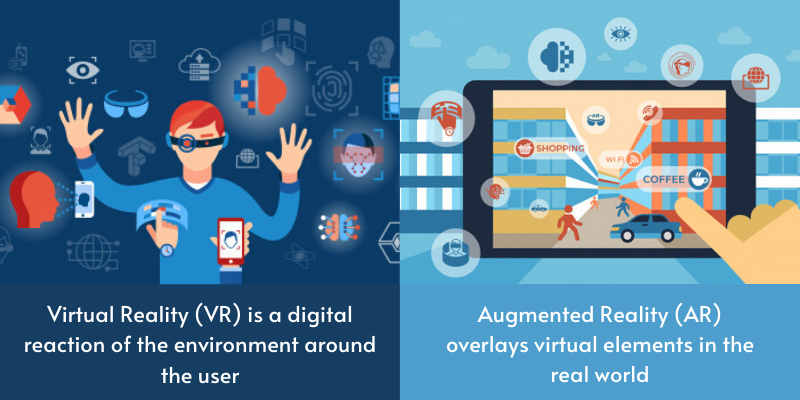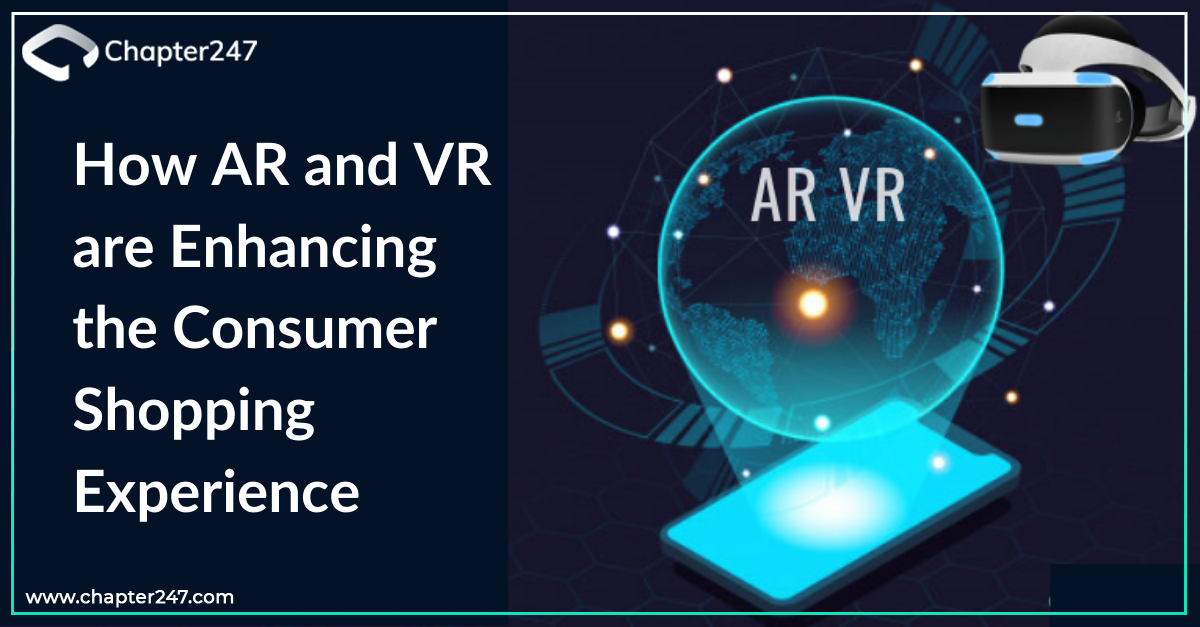In recent years, shopping applications have seen the embracing of the most advanced technologies that have transformed the conventional business landscape. Augmented Reality (AR) and Virtual Reality (VR) have literally transformed the way, people purchase their products.
VR is increasingly becoming more mainstream, and in 2018, 24 million virtual reality and augmented reality devices were sold.
VR is for sure a budding technology and together with AR, it carries the prospect to revamp the retail space by overhauling the entire shopping experience. Technology is tantamount to continuous enhancements and if it is not that way then there is something wrong. What was yesterday is courses far away from what is today. Technology is in this humongous field of computer science that includes AR and VR.
Point to ponder- How will AR and VR enhance the consumer experience?
Now for starters, AR and VR imply our experience of something that is not there, but it feels like it is there. Before getting them in reality, you can experience the offering lending you a helping hand in making decisions.
“Virtual Reality may be a technology that might truly permit you to attach on a truly human level, soul to soul, in spite of wherever you are within the human world.” – Chris Milk.
In this article, we intend to uncover everything there is about how VR & AR are truly turning the tables for the retail sector. We will cover-
1. How are AR and VR essentially different from each other?
2. Business benefits of implementing AR & VR in your shopping applications
3. Focus on the numbers and trends and finally
4. Talk about some real-life use cases of AR and VR
How is AR different from VR?
AR and VR are usually talked about in the same breath and considering the current market capabilities it will not be wrong to equate them.
However, VR and AR are distinctly different. VR happens to get more coverage while AR, on the other hand, can get ambiguous considering the number of ways we can deploy it.

Clearly, the image shows a huge difference between the capabilities of AR and VR!
VR eliminates the user from the real-world experience, replacing it with a simulated one while AR allows the user to experience the real world which is digitally augmented. VR devices when used shut the user out of the physical world totally as it requires 100% captivation. The lens which AR capabilities use is transparent.
So, VR places the users in the virtual world and usually requires the usage of specialized headsets while AR involves superimposing computer-created information to the real-world vision and is mostly accessible by people on their mobile devices.
The below-given illustration clearly shows the year over year reality about these technologies. AR clearly makes the cut.

Source: eMarketer
Point to ponder – Did you know the US has a large number of takers for AR compared to VR? Reason out with us!
Let’s get a deeper understanding of the real-world case of Honeywell.
The company was facing the issue of an aging workforce. Hence, rather than hand-typing or writing the requisite training documents its pro-administration professionals took up these technologies. They donned AR headsets to record the tasks they were doing in the best possible manner. These recorded versions would then be used to train the younger generation, millennial workers, in a truly digitally assisted manner. The technique seemed to work as 80% of what was given was retained by the new teams compared to 20% to 30% which they otherwise would have remembered.
Johnson & Johnson Institute has created a virtual reality software to improve training for surgeons and nurses. Walmart also uses VR to create improbable situations like weather emergencies for a rigorous training experience without the need to discard regular operations.
How VR augments customer experience?
VR is set-up with advanced software with a simulated reality feature with advanced features. The user upon viewing it will accept it as true. Our good old 3D image is a true example of VR. It replaces the real space because the user becomes a part of the virtual environment while fiddling with various objects within the implied world. Retail businesses are truly employing this pioneering technology and are experiencing immense business benefits:
Increased engagement
VR-Based shopping applications and E-commerce sites have steered customer engagement because the various mobile applications for shopping have successfully infused 3D vision to the products. Businesses have managed to increase customer delight and loyalty by using innovative ways to conduct business conversations for delightful customer experience.
Users can explore Virtual showrooms
Retailers now have started building virtual showrooms to entice and excite the customer. A never seen before the virtual experience is very close to being in a physical store from the comforts of your home. Lowe’s Holoroom is one such example which is using this technology to the best of its ability. Its innovation lab has proved that by using a virtual showroom, the customer is able to visualize home improvement projects in a better manner. It gives a mock-up test version of how your home could look when you use various products. Whatever their preferences are, they can envision the entire look with a virtually generated and immersive experience.
Consumers can visualize the products
Try before you buy!
Yes, companies now are giving this convenience to customers to visualize how the product will look before its purchase. Instead of actually focussing only on VR companies also have delved into using AR. Companies are using both to ensure the product is presented in its best forms. Customers can put the headset and can instantaneously see the room they were standing in. AR then lets the products to be overlaid on their view. Users can all of a sudden see a beautiful dress that they were thinking of buying. In order to give a clearer picture to customers about how various products will fit in their life, AR is able to provide a better visualization compared to physical stores.
Taking this further, IKEA which is the famous Swedish furniture brand has already launched an AR catalog which lets the user see how different furniture items will fit in your home. According to the product’s dimensions, you will be able to clearly see how the furniture pieces will fit in your homes. Our vigorous process for eCommerce site development allows our users to experience a never-seen-before experience.
Talking about more shopping applications, retail giants like Lego and converse also have started using AR to show how some products will appear. These forms of visualizations provide a whole new dimension to customer interaction. Customers can make well-informed decisions about the physicality of the product due to these technologies rather than only reading product manuals.
Gives customers a reason to visit the store
We all still prefer to physically go to a store and purchase any product in reality not only because it warrants good quality but also it is an experience. In fact, a survey was undertaken by Walker Sands Future of retail in 2016 among 1400 US shoppers clearly elucidated that they prefer in-store experiences compared to going online. While there is no denying that shopping applications online are showing no signs of slowing down, this growth is more to do with convenience. Ecommerce shopping applications leaders need to think about this because it is the right time to ensure that customers get close to reality experience.
AR right in physical stores
AR devices also let companies launch extra content and information in their stores. This provides a golden opportunity for companies to offer fresh in-store engagement ideas to make the customers interested.
Point to ponder – Imagine a customer walking into a retail store and picking up an AR headset. With that on, the customer starts wandering around the store. With the headset on, as and when they move across the store, AR will enable a pop-out to emerge waiting to tell the customer more about the product they are looking at. If your retail store also wants to run an in-house promotional game it can enable the timely appearance of promotional boxes.
Are you looking to create such experiences for your customers? Turn to us for next-generation VR & AR experiences right here.
Such features not just enhance the customer journey but also show that a regular shopping experience can go way beyond a simple reality because it is the mix of augmented and immersive experience.
Virtual testing of the products
Practise is the key to effective learning. VR can be utilized to improve customer service by improving the training of the agent. New employees can now do better with enhanced communication skills by facing situations in the virtual world. Right from the routine experiences to really complicated ones, they can devise strategies to work their way out of the situation. VR lets these customer support agents become more knowledgeable and lets the user explore different products without touching it animatedly.
Real-time customer feedback
Are you looking at ways to ensure that you form an unbreakable bond with your customers? Conventional ideas are passe because now companies have to devise plans to let customers experience extraordinary experiences. One of the best ways to do it is AR and VR. AR is increasingly creating inroads in different shopping applications and mobile applications for shopping. Holography is used in training for a virtual hands-on guide more so to orient the user. It also can mimic real-life situations like a sales interaction gone wrong or an emergency situation on the shop floor.
Numbers do the talking
AR & VR in the retail space especially in shopping applications are becoming more popular with major retail giants like IKEA and Lowe showing their presence. Retail seems to be the perfect space for shopping applications to embrace the technology of AR & VR. It presents the perfect environment for the implementation of AR & VR solutions.
Why are retail applications more embracing of AR & VR at a rapid pace? Ask our experts.
In other sectors too, VR & AR implementation is possible but the lack of a proper business plan presents the biggest roadblock. For the application to function as a standalone product, the business model matters a lot. The demand for AR & VR in virtual reality shopping applications has augmented. Let us observe some numbers.


Source: Statista
A Retail Perceptions report found out that
- Close to 77% of customers demanded customized features;
- 65% required comprehensive product information;
- 55% claim that when AR is implemented in the shopping experience, it becomes more fun.
Shining examples of AR and VR – Its applications
The virtual assistant app of Sephora makes use of the VR technology for a customized shopping experience on its shopping application. The shopping application enables the user to try out varied make-up applications before deciding what to go for. Users could also learn how to apply make-up with their extensive video coverage.

This results in augmenting the customer experience holistically and more importantly has helped the shopping application gather more conversations and reduced returns and refunds.
Win-Win situation for this unique mobile application for shopping!
Such improvements make it pretty easy for consumers to seek the product. The real-time immersive user experience has the potential to have higher conversion rates across the retail industry. The average estimated conversion rate through this online shopping application is 2.35% and with VR this might get a further boost.
Another great way to enhance user experience was the use of VR by NewYork fashion week. The guests here were given a chance to virtually see a prestigious fashion event that took place in Milan the previous week with the help of VR headsets. The 360-degree videos helped the users catch glimpses of the curated fashion collections and provided them a next to red-carpet experience.
Patrón Tequila used VR to transport its audience and explain to them how their product evolved from its plan to a cocktail lounge. This premium tequila brand used a blend of live videos embossed with 3D graphics for showing “The Art of Patrón Virtual Reality Experience”. This is shown not just at live events but also at various retail points. The audience could take a virtual tour of the company’s distillery located in Mexico which also helped them reestablish the top-notch quality to deliver their goods.
Virtual reality endeavors took about 6 months to execute but gathered 20,0000 Youtube views at first go clearly showing the power of immersive storytelling strategies.
Something to think about
In conclusion, the only point that remains is whether AR & VR experience of shopping applications will further evolve and if yes how far?
We believe that many retailers across the sector have already started reaping the benefits of AR and VR technologies. The positive response from the consumers has now started pushing the industry to slowly adopt strategies for a positive eCommerce site development. Both these technologies are expanding the horizons of conventional services and the future of retail is rock steady with this new development.








